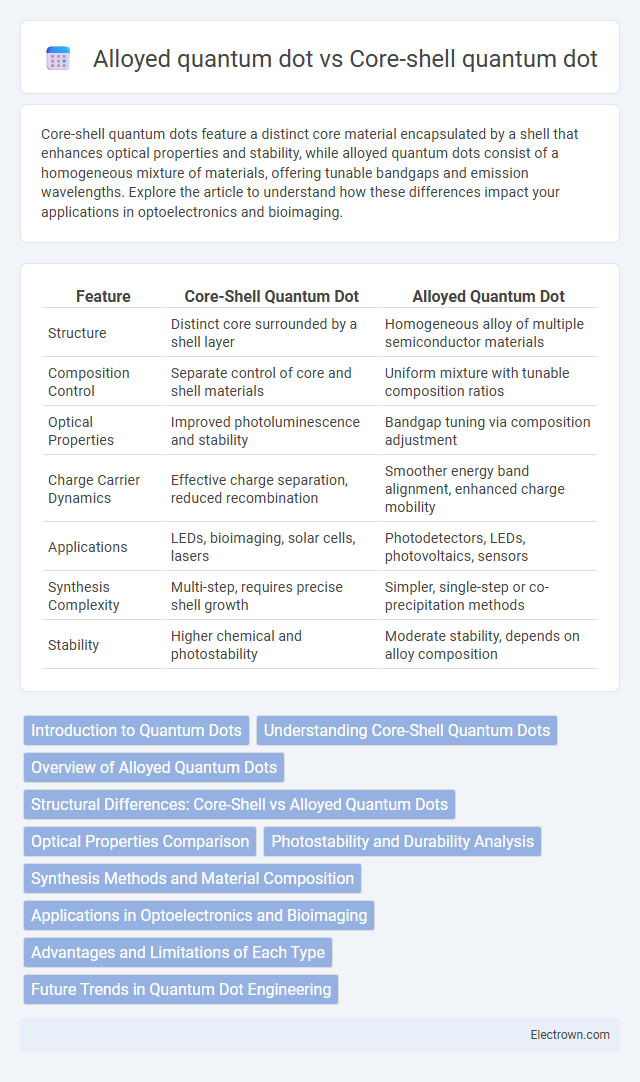Core-shell quantum dots feature a distinct core material encapsulated by a shell that enhances optical properties and stability, while alloyed quantum dots consist of a homogeneous mixture of materials, offering tunable bandgaps and emission wavelengths. Explore the article to understand how these differences impact your applications in optoelectronics and bioimaging.
Table of Comparison
| Feature | Core-Shell Quantum Dot | Alloyed Quantum Dot |
|---|---|---|
| Structure | Distinct core surrounded by a shell layer | Homogeneous alloy of multiple semiconductor materials |
| Composition Control | Separate control of core and shell materials | Uniform mixture with tunable composition ratios |
| Optical Properties | Improved photoluminescence and stability | Bandgap tuning via composition adjustment |
| Charge Carrier Dynamics | Effective charge separation, reduced recombination | Smoother energy band alignment, enhanced charge mobility |
| Applications | LEDs, bioimaging, solar cells, lasers | Photodetectors, LEDs, photovoltaics, sensors |
| Synthesis Complexity | Multi-step, requires precise shell growth | Simpler, single-step or co-precipitation methods |
| Stability | Higher chemical and photostability | Moderate stability, depends on alloy composition |
Introduction to Quantum Dots
Quantum dots are semiconductor nanoparticles with unique optical and electronic properties driven by quantum confinement effects. Core-shell quantum dots consist of a semiconductor core encapsulated by a shell material, enhancing stability and photoluminescence efficiency. Alloyed quantum dots are formed by mixing two or more semiconductor materials at the atomic level, allowing tunable band gaps and emission wavelengths for tailored applications.
Understanding Core-Shell Quantum Dots
Core-shell quantum dots feature a semiconductor core encapsulated by a shell of a different material, enhancing optical properties and stability by reducing surface defects and non-radiative recombination. Alloyed quantum dots, in contrast, consist of a homogeneous mixture of two or more semiconductor materials, offering tunable bandgap energies through composition variation but often with less structural stability than core-shell counterparts. Your choice between core-shell and alloyed quantum dots depends on the desired balance between optical performance, chemical stability, and synthesis complexity.
Overview of Alloyed Quantum Dots
Alloyed quantum dots consist of a homogeneous mixture of different semiconductor materials, enabling tunable optical and electronic properties through precise control of composition. These quantum dots offer enhanced stability and reduced toxicity compared to core-shell structures, making them ideal for applications in bioimaging and optoelectronics. Your choice between core-shell and alloyed quantum dots depends on the specific requirements for emission tunability, stability, and biocompatibility.
Structural Differences: Core-Shell vs Alloyed Quantum Dots
Core-shell quantum dots feature a distinct core material encapsulated by a shell with different composition, enhancing optical properties and stability through spatial separation of charge carriers. Alloyed quantum dots consist of a homogeneous mixture of two or more semiconductor materials, resulting in tunable bandgap energies and uniform composition throughout the nanocrystal. Your choice between these structures affects electronic properties, with core-shell designs offering improved quantum yield and alloyed dots providing adjustable emission spectra.
Optical Properties Comparison
Core-shell quantum dots exhibit enhanced optical properties due to the protective shell that reduces surface defects and non-radiative recombination, resulting in higher quantum yields and improved photostability. Alloyed quantum dots, composed of a homogeneous mixture of materials, offer tunable emission wavelengths and narrower emission spectra, enabling precise control over optical characteristics. Your choice between core-shell and alloyed quantum dots depends on the desired balance between photostability and spectral tunability for specific applications.
Photostability and Durability Analysis
Core-shell quantum dots exhibit superior photostability compared to alloyed quantum dots due to their distinct core and shell structure, which effectively passivates surface defects and reduces photobleaching. Alloyed quantum dots, while offering compositional tunability, often show reduced durability under prolonged light exposure due to alloy-induced lattice strain and potential surface degradation. Understanding these differences helps you select the most reliable quantum dot type for applications requiring long-term performance and stability.
Synthesis Methods and Material Composition
Core-shell quantum dots are synthesized through a two-step process involving the initial formation of a semiconductor core followed by the controlled growth of a shell layer, typically composed of a different semiconductor material to enhance optical properties and stability. Alloyed quantum dots are created using a single-step synthesis or co-precipitation method where multiple semiconductor precursors are simultaneously introduced, resulting in a homogeneous material composition with tunable bandgap properties. Your choice between core-shell and alloyed quantum dots depends on the desired balance between synthesis complexity and customizable electronic or optical characteristics.
Applications in Optoelectronics and Bioimaging
Core-shell quantum dots exhibit enhanced photostability and tunable emission wavelengths, making them ideal for high-efficiency optoelectronic devices like LEDs and solar cells. Alloyed quantum dots offer compositional uniformity and broad spectral tunability, which benefits multiplexed bioimaging and deep tissue penetration. Your choice between these quantum dots should consider the specific stability and spectral needs of your optoelectronic or bioimaging application.
Advantages and Limitations of Each Type
Core-shell quantum dots offer enhanced photostability and higher quantum yields due to their distinct core and shell structures that reduce surface defects and non-radiative recombination. Alloyed quantum dots provide tunable optical properties and improved chemical stability by evenly distributing elements within a single nanocrystal, but they may suffer from less precise control over emission wavelengths compared to core-shell designs. Your choice depends on whether you prioritize superior brightness and durability (core-shell) or customizable emission spectra and stability (alloyed).
Future Trends in Quantum Dot Engineering
Core-shell quantum dots offer tunable optical properties and enhanced stability by combining a semiconductor core with a different shell material, enabling precise control over emission wavelengths. Alloyed quantum dots integrate multiple elements within a single crystalline structure, providing continuous compositional gradients that facilitate enhanced photostability and customizable electronic characteristics. Future trends in quantum dot engineering emphasize hybrid architectures and advanced synthesis methods to optimize quantum efficiency, reduce toxicity, and expand applications in optoelectronics and bioimaging.
Core-shell quantum dot vs Alloyed quantum dot Infographic

 electrown.com
electrown.com